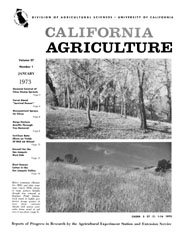All Issues

Cover:
Before treatment (December, 1959) and after treatment (April, 1966) photos of range pasture benefits through tree removal at Hopland Field Station. Good stand of highly productive forage grasses in lower photo contrasts sharply with sparse cover under dense stand of oak trees in top photo.
January 1973
Volume 27, Number 1
Volume 27, Number 1





